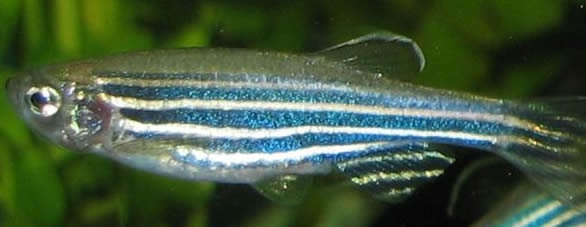
Adult Zebrafish (Danio Rerio)
"Almost all other animals are clearly observed to partake in sleep, since fishes of all kinds...have been seen sleeping"
-- Aristotle, On Sleep and Sleeplessness 350 B.C.E.

Adult Zebrafish (Danio Rerio)
Sleep has fascinated poets, playwrights, philosophers, and scientists for thousands of years. More recently, increased public and clinical attention has been paid to the negative health consequences of the lack of adequate sleep. Despite this scrutiny, the mysteries of sleep’s function and regulation endure. Why is sleep essential for animals as diverse as flies and humans? And what are the regulatory genes and neuronal circuits that control the timing, amount, and duration of sleep?
Zebrafish. In the Rihel lab, we use zebrafish as a model system to investigate sleep. The zebrafish is an attractive model system for sleep studies because they develop rapidly, exhibiting a complex behavioral repertoire, including circadian rhythms, feeding, and sleep by the fifth day of development. The zebrafish larvae are also optically transparent, facilitating the direct study of neural circuits. Furthermore, zebrafish possess much of the conserved brain circuitry thought to regulate sleep in humans. Thus, the zebrafish model is uniquely suited for sleep studies, as it combines the genetic tractability of invertebrate models with the sleep-relevant neural anatomy and physiology of mammals.
Click on the following images to learn more about some of the projects in the lab:
Home
People
Publications
Positions Available
Photos
Funding
Sleep Links
Zebrafish Links
How to Find Us
Research Projects
Measuring Sleep in Zebrafish.